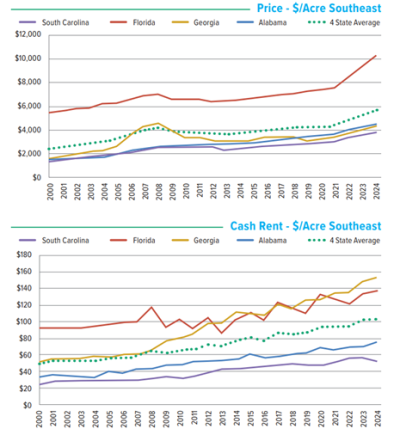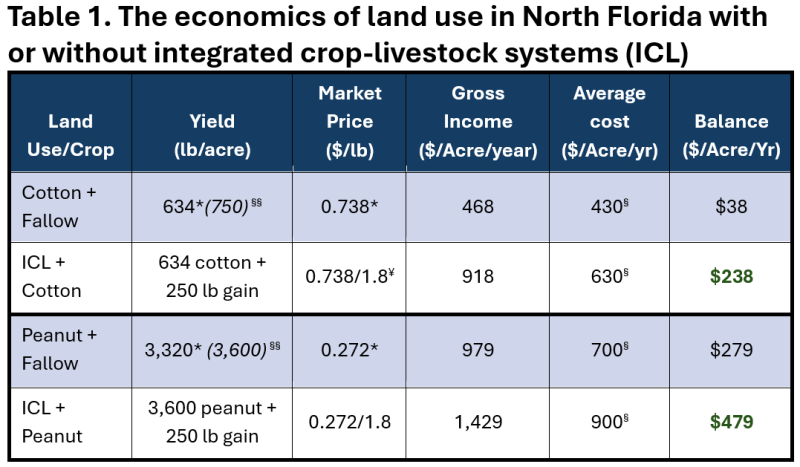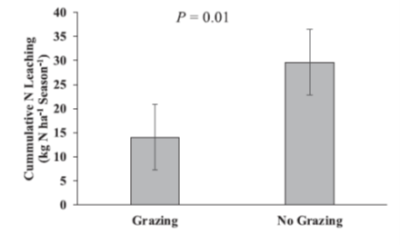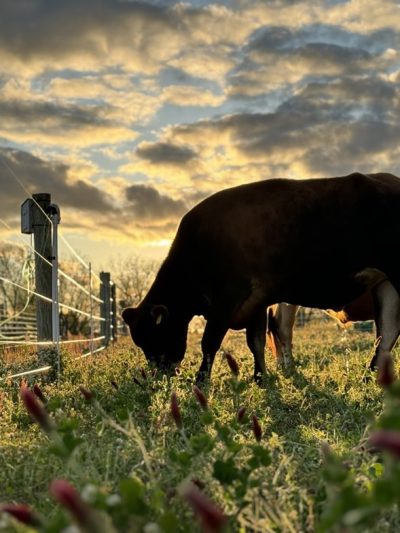Jose Dubeux, Luana Queiroz, Igor Bretas, Kevin Trumpp, Kenneth Oduor, Liza Garcia, UF/IFAS North Florid Research and Education Center – Marianna
Introduction
Grazing cover crops is a triple win, because it can benefit row crop farmers, livestock producers, and the environment (win-win-win). Florida, Alabama, and Georgia have 4.1 million acres of row crops including peanut, cotton, corn, and soybean. Most of this land (95%) lays fallow from October through April. This is also the time of the year when you can plant winter forages and develop heifers or stockers reaching an average daily gain of 2 lbs./head/day without feed supplements, just grazing. Using this fallow land during the winter can also help row crop farmers, who can benefit not only with direct income from the cattle operation, but also indirectly because cattle grazing has been shown to improve soil characteristics and, in some cases, improve the yield of the cash crops. Furthermore, fertilizer applied during the grazing phase can benefit the cash crop phase, reducing the costs of fertilizer inputs. Finally, grazing cover crops can reduce nitrate leaching, benefiting the environment as well. The four principles (4 M’s) to improve sustainability and soil health require maximizing the presence of live roots during the year, minimizing disturbance, maximizing soil cover, and maximizing diversity both in space and time (Figure 1). Integrating livestock into cropping systems helps to cover all these four principles leading to improved soil health with time.
–
Benefits for Row Crops

Figure 2. Price of land and cost of leasing in the Southeast U.S. (FL, AL, GA, SC). Source: National Land Value, Fall 2024, Peoples Company Report.
Most of the row crop land (95%) is fallow during the winter in the tri-state region of Florida, Alabama, and Georgia. Harvests of the primary crops typically start in mid-to-late September and end in late October to early November. This land could be used from October until April to develop another cropping system that could bring revenue to the landowner and/or land tenant. Most of the row crop land in this tri-state region is leased land, and there is a trend to increase the cost of leasing because of the increasing price of land (Figure 2). Higher land prices lead to higher leasing costs. Therefore, having another economic activity during the winter might help to accommodate higher leasing costs and make the land more profitable.
Integrating cattle to graze cover crops during the wintertime might improve the row crop productivity, or in many cases it doesn’t affect their yields (Santos et al., 2022). Thus, adding cattle would bring additional revenue without reducing the cash crop profits. In fact, there are benefits such as the increase of soil organic matter and potential reduction of fertilizer inputs during the cover crop phase, which can increase the overall efficiency and help to mitigate some production costs. Integrating cattle into both cotton and peanut rotations might improve the overall profitability of the system (Table 1).

*USDA/NASS 2023 State Agriculture Overview for Florida
§DL Cotton = $430 and IRR Cotton = $520; DL Peanut = $600 and IRR Peanut = $700; $250/acre for cool-season forages
§§Historical average for cotton and peanut.
¥We used $1.80 per lb. of live weight gain. We understand that current prices are much higher but opted to use a more conservative value for long-term comparison.
–
Benefits for Livestock
The cool-season is the prime time to put gain on cattle. It is possible to obtain gains averaging 2 lbs./hd./d. just on grazing. This is a real opportunity to develop heifers and/or to have stocker systems. Skills are required to select the right cattle and to mitigate the risks associated with weaned calves, however, this is also a real opportunity to make profit. Cattle return most of the nutrients they ingest, improving soil characteristics when cool season forages are well managed. The benefit of re-integrating livestock to row crop land is enormous, considering all the nutrient cycling process and the benefits they bring to the land (Figure 3). The complexities associated with different production systems (row crops and livestock) could be resolved by partnering a row crop farmer and a livestock producer together on the same land. In fact, the Southeast Grazing Exchange website facilitates this partnership. This also opens opportunities to engage the young generation to start farming.
–
Benefits for the Environment

Figure 4. Nitrate leaching in grazed versus non-grazed systems in North Florida. (Santos et al., 2023)
Grazing cover crops brings additional benefits to the environment. Nitrate leaching reduces significantly when cover crops are added to the system, and grazing cover crops reduces nitrate leaching even further (Figure 4, Santos et al., 2023). Therefore, developing ICL systems is also a win for the environment.
–
Take Home Message
Reconnecting livestock to cropping systems might help to increase farm profitability and pay for the increasing costs of leasing. Row crops typically benefit from grazing during the cover crop phase, with research results showing possible increase in soil organic matter and reduction in fertilizer input. There are challenges that are faced when dealing with multiple production systems but partnering row crop farmers with livestock producers to work on the same land might help to alleviate these challenges. Finally, the environment also benefits from integrated systems, with a reduction in the nitrate leaching.
–
References
Santos, E.R.S., J.C.B. Dubeux, Jr., L.E. Sollenberger, C.L. mackowiak, D.L. Wright, N. DiLorenzo, M.C.B. Siqueira, C.C.V. Garcia, L.M.D. Queiroz, F.O.S. van Cleef, L. Garcia, D.M. Jaramillo, M. Ruiz-Moreno. 2022. Grazing management effects on cover crop responses and cotton lint yield. Crop Science. 2022; 62:2523-2536.
–
Santos, E.R.S., J.C.B. Dubeux, Jr., C.L. Mackowiak, D.L Wright, G. Anguelov. 2023. Integrated crop-livestock systems result in less nitrate leaching than ungrazed crop systems in North Florida. J. Environ. Qual. 2023; 52:847-858.
- Grazing Cover Crops is a Triple Win! - August 15, 2025
- How are My Cool-season Forages Recovering from the Snowfall and Low Temperatures? - January 31, 2025
- Integrated Crop-Livestock Systems Improve Soil Health - July 26, 2024


